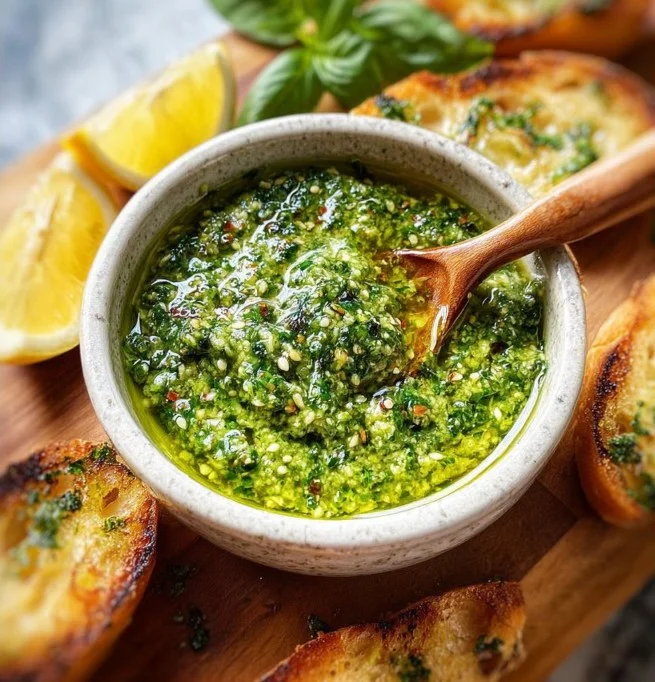Last updated on July 1, 2025
There’s something incredibly comforting about the aromatic, vibrant green goodness of basil pesto. When I think about my first experience making it, I can’t help but chuckle at the chaos that ensued. Picture this: a food processor that sounded like it was auditioning for a horror movie, basil leaves flying everywhere, and me frantically trying to remember if I had all the ingredients I needed. It was a comedy of errors! But more than that, it turned into a delightful memory that I cherish every time I whip up a fresh batch.
If you’ve ever found yourself wondering how to make pesto or feeling a bit intimidated by the idea, rest assured that you’re not alone. Many beginner cooks hesitate at the thought of ruining their dish or struggle with step-by-step instructions that seem too complicated. Cooking can feel daunting, and the fear of the unknown often keeps us from trying new things in the kitchen.
But I’m here to tell you that making basil pesto is not only simple but also totally doable—even if it’s your very first time. Trust me, with just a few fresh ingredients and a food processor, you’ll be on your way to creating a cozy, homemade classic that will elevate any dish it touches.
Table of Contents
Ingredients You’ll Need for Basil Pesto
Before we dive into the steps of making this delicious sauce, let’s take a closer look at the ingredients. In order to create the perfect basil pesto, you’ll want to gather the following essentials:
Print
Homemade Basil Pesto
- Total Time: 15 minutes
- Yield: About 1 cup of pesto 1x
Description
This fresh basil pesto is packed with flavor, made with toasted pine nuts, garlic, lemon, and optional Parmesan. Perfect for pasta, sandwiches, or as a dip, this homemade pesto is bright, herby, and irresistibly delicious!
Ingredients
Essentials:
- 1/2 cup toasted pine nuts
- 2 tablespoons fresh lemon juice
- 1 small garlic clove
- 1/4 teaspoon sea salt
- Freshly ground black pepper, to taste
- 2 cups fresh basil leaves
- 1/4 cup extra virgin olive oil (more as needed)
- 1/4 cup freshly grated Parmesan cheese (optional)
Optional Add-Ons:
- Different nuts (walnuts, almonds, pecans)
- Sunflower seeds for nut-free version
- Additional herbs (parsley, cilantro, arugula)
Substitutions and Shortcuts:
- Store-bought pesto or fresh spinach/kale instead of basil
- Pre-toasted pine nuts or pre-made gourmet pesto for convenience
Instructions
- Prepare Ingredients: Gather and prep all your ingredients before you start.
- Blend Base Ingredients: In a food processor, pulse toasted pine nuts, lemon juice, garlic, salt, and black pepper until finely chopped.
- Add Basil: Add fresh basil leaves and pulse again until combined but not fully smooth.
- Drizzle in Olive Oil: With the processor running, slowly drizzle in olive oil until the pesto reaches your desired consistency.
- Add Parmesan: If using, pulse in the freshly grated Parmesan cheese just until incorporated.
- Taste & Adjust: Taste and adjust seasoning—add more salt, lemon, or garlic to suit your taste.
- Serve or Store: Use immediately or store in a sealed jar with a thin layer of olive oil on top. Refrigerate for up to one week.
Notes
- To freeze: Spoon pesto into ice cube trays, freeze until solid, then transfer cubes to a zip-top bag for later use.
- Roasted garlic can be used for a milder flavor.
- If pesto thickens in the fridge, stir in a bit of olive oil before using.
- Prep Time: 10 minutes
- Cook Time: 5 minutes (for toasting nuts)
- Category: Condiment, Sauce
- Method: Blending
- Cuisine: Italian
Nutrition
- Serving Size: 2 tablespoons
- Calories: 120
- Sugar: 0g
- Sodium: 85mg
- Fat: 12g
- Saturated Fat: 2g
- Unsaturated Fat: undefined
- Trans Fat: undefined
- Carbohydrates: 2g
- Fiber: 0.5g
- Protein: 3g
- Cholesterol: undefined
Keywords: basil pesto, homemade pesto, Italian sauce, easy pesto recipe, fresh pesto, vegetarian pesto, nut-free pesto option
Essentials
1/2 cup toasted pine nuts
Pine nuts bring a delightful nuttiness to the pesto. Toasting them enhances their flavor, making your pesto even more aromatic. You can toast them in a dry skillet over medium heat for about five minutes, shaking the pan occasionally to prevent burning.2 tablespoons fresh lemon juice
Fresh lemon juice brightens up the dish and balances the richness from the nuts and olive oil. It’s important to use fresh juice for the best flavor—don’t reach for the bottled stuff!1 small garlic clove
Garlic adds depth and a hint of savory goodness. If you prefer a milder flavor, you could use roasted garlic instead.1/4 teaspoon sea salt
Just a touch of salt enhances all the other flavors in your pesto. Make sure to taste and adjust to your liking.Freshly ground black pepper
A few cracks of black pepper add a little zing! You can adjust the quantity based on your personal preference.2 cups basil leaves
Fresh basil is truly the star of the show! Choose vibrant green leaves that are fragrant and free of blemishes.1/4 cup extra virgin olive oil
Olive oil not only helps bring everything together but also contributes a luscious texture. If you prefer a smoother pesto, feel free to add more olive oil as you blend.1/4 cup freshly grated Parmesan cheese (optional)
Parmesan cheese adds a nutty and savory flavor. It’s optional, but I promise it makes a difference.
Optional Add-Ons
Now, you can customize your pesto if you want! Here are a few tasty options:
- Different Nuts: Try substituting pine nuts with walnuts, almonds, or pecans for a unique twist.
- Nut-Free Version: If allergies are a concern, feel free to omit the nuts altogether. You can replace them with sunflower seeds or simply increase the cheese and herbs.
- Herb Variations: Mix in other fresh herbs like parsley, cilantro, or arugula to create your own signature blend.
Substitutions and Shortcuts
- If fresh basil is unavailable, look for store-bought pesto to use as a base or opt for other fresh herbs like spinach or kale for a twist.
- To save time, some grocery stores sell pre-toasted pine nuts, or you could buy a tube of pre-made pesto in the gourmet aisle—they can be convenient options!
How to Make Basil Pesto Step-by-Step
Ready to make your own basil pesto? Let’s get started with these straightforward steps that ensure you’ll create something delicious and fragrant in no time.
Step 1: Prepare Your Ingredients
First things first—gather all your ingredients. This ensures that you won’t be scrambling halfway through the process. Once that’s done, I’ll walk you through the blending process.
Step 2: Bowl the Nuts, Garlic, and Seasonings
In your food processor, combine the toasted pine nuts, fresh lemon juice, the small garlic clove, sea salt, and freshly ground black pepper. Pulse until everything is well chopped. You want a nice, slightly grainy texture—so don’t over-process just yet. If your mixture seems a bit too dry, drizzle in a smidge of olive oil to help loosen it up.
Step 3: Add the Basil
Now it’s time for the star ingredient—fresh basil leaves! Gently add the basil leaves to your processor. Pulse again until the basil is fully incorporated into the mixture, which should take just a few more pulses.
Step 4: Drizzle in the Olive Oil
With the processor running, take a steady hand and drizzle in the extra virgin olive oil. This should create a creamy consistency, blending beautifully with the other ingredients. If you prefer a smoother texture, go ahead and add more olive oil as you blend.
Step 5: Incorporate the Cheese (If Using)
Finally, if you’re opting for Parmesan cheese, add it to the pesto mixture and pulse briefly to combine. Just enough to mix it in—the cheese should still show a bit of texture.
Step 6: Taste and Adjust
Now comes the fun part—taste your pesto! This is your chance to adjust the seasonings. Perhaps you need a pinch more salt, a dash of lemon juice, or maybe a little more garlic. Don’t be shy—make it tailored to your own palate.
Step 7: Store or Serve
Once you’re satisfied with your pesto, it’s time to decide what to do with it. You can serve it right away over pasta, spread it on sandwiches, or use it as a dip for vegetables. If you have leftovers, transfer the pesto to a jar and cover it with a thin layer of olive oil to keep it fresh. Stored in the fridge, it should last about a week—just remember to give it a good stir before serving.
Common Mistakes to Avoid
Even with a simple recipe like basil pesto, there are a few common pitfalls that beginners might encounter. Here’s how to avoid them:
Overprocessing the Mixture
While blending your ingredients, it’s crucial not to overprocess the mixture. Your goal is to create a coarse texture, but if you keep the food processor running too long, you might end up with a paste that’s more suited for a spread than a pesto. A few pulses should suffice.
Skimping on Fresh Ingredients
Pesto is all about fresh flavors, and using wilted or old basil can significantly impact your dish. Always opt for the freshest ingredients you can find, particularly in the basil department. The taste will reflect that freshness!
Forgetting to Taste
Never skip the tasting step! It’s important to taste your pesto before serving. Adjust the seasonings to your liking—some may enjoy a little extra salt or lemon juice. A little adjustment here and there can elevate your dish tremendously.
Ignoring the Storage Tips
If you make a big batch, you might want to save some for later. It’s essential to store your pesto properly to maintain its freshness. Covering it with olive oil prevents oxidation, which keeps that vibrant green color intact!
Quick Wins for Beginner Cooks
When it comes to cooking, especially as a beginner, it’s always nice to have some easy tips up your sleeve. Here are a few quick wins that will help you become a more confident cook in no time.
Prepped Ingredients Are Your Best Friend
Before you start cooking, take the time to pre-measure and prep all your ingredients. This will not only make the cooking process smoother but also give you an organized approach, reducing stress in the kitchen.
Use Quality Tools
Investing in a good food processor can be a game-changer. A decent machine will cut down on prep time and give you beautiful, consistent results. If you’re using a lower-quality processor, you may find yourself struggling with texture.
Experiment with Texture
Don’t be afraid to play around with the texture of your pesto! If you like it chunkier, pulse less. If you want it silky smooth, add olive oil bit by bit and keep blending. You’re in control, so make it your own!
Make It a Family Activity
Cooking can be a wonderful opportunity to bond with family or friends. Get your loved ones involved when making basil pesto! It’s an easy recipe to follow, and sharing the experience can make it even more enjoyable.
Pro-Level Tips for When You’re Ready
Once you’ve mastered the basics of basil pesto, you might want to take your skills to the next level. Here are a few pro tips:
Experiment with Flavor
The wonderful thing about pesto is that it’s versatile. Feel free to experiment! Add chili flakes for heat, sun-dried tomatoes for sweetness, or even some roasted red peppers for a unique twist.
Try Alternative Oils
While olive oil is typically used, you can experiment with different oils such as avocado oil or nut oils for a fresh flavor profile. These oils can add depth and nuance to your pesto.
Make Different Versions
Don’t limit yourself to just basil! Use other herbs and greens like mint, parsley, or even spinach for new variations. You can mix and match according to what you have on hand—whether it’s frozen herbs in the winter or fresh summer greens.
Amplify Your Presentation
Once you’ve perfected the taste of your pesto, consider the presentation. Drizzle a bit of olive oil over the top and garnish with extra pine nuts or a sprinkle of Parmesan cheese. A beautiful presentation adds to the overall experience when serving!
FAQs About Basil Pesto
What can I use basil pesto for?
Basil pesto is incredibly versatile! You can toss it with pasta, spread it on sandwiches, use it as a pizza sauce, drizzle it over roasted vegetables, or even use it as a dip for crackers.
Can I freeze basil pesto?
Yes, basil pesto freezes beautifully! Just spoon it into ice cube trays or small containers, cover it with a layer of olive oil, and it should keep for about six months. Thaw in the fridge when you’re ready to use it.
Is it necessary to use Parmesan cheese in basil pesto?
It’s not necessary! While Parmesan adds a lovely flavor, you can skip it for a dairy-free option or substitute with nutritional yeast for a similar, cheesy taste.
Can I make basil pesto without a food processor?
Absolutely! You can use a mortar and pestle for a traditional approach, or finely chop all the ingredients by hand. It will take more time, but the results can be just as delicious.
What are some variations of basil pesto?
You can try using different nuts like walnuts or cashews, add other herbs like parsley, or even incorporate greens like spinach or kale. Get creative and make it your own!
Conclusion & Next Steps
Congratulations! You’ve learned how to make basil pesto from scratch. It’s easier than it looks, and now you have the skills to create a dish that’s both comforting and classic. Remember that you can customize the recipe to suit your taste, and as you gain confidence, don’t hesitate to experiment with different ingredients.
Now that you have this cozy, beginner-approved recipe under your belt, it’s time to put it into action. Whip up a batch of basil pesto today and elevate your meals! Also, I would love to hear your creations—please share your experiences or any fun variations you come up with. Happy cooking!
Looking for more delicious recipes? Follow us on Pinterest and Facebook!





